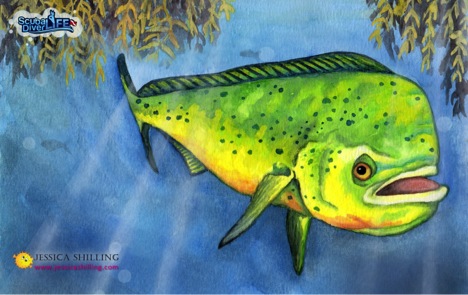The Mahi-Mahi is a surface-dwelling pelagic fish found in off-shore temperate, tropical and subtropical waters worldwide. Mahi-Mahi are quick and swift game fish marked with strikingly beautiful bright colors. They have compressed golden yellow bodies marked with iridescent blues and greens and a long dark blue dorsal fin extending nearly the entire length of their bodies. They have a large fork tail and their bodies can be spattered with dots of blue and green. These colors can change rapidly, excited fish “light up”, and dying Mahi-Mahi loses its colors and turns silvery grey.
Illustration by Jessica Shilling author of children´s picture book series “Fins and Tales“:
One distinguishing characteristic between the between mature males and females, the male has a very rounded head profile and the female´s head slopes down to the mouth.
Mahi Mahi are scientifically named Coryphaena hippurus, they go by many other names like, Dolphin, Dorado, or Goldmakrele. The name Mahi-Mahi means very strong in Hawaiian.
Mahi Mahi are one of the fastest fish in the sea and are also one of the fastest growing fish. Their average life span is 4 years and they can grow up to 80 pounds in only 2 years. Males and females are sexually mature usually by 4-5 months old. Mahi Mahi spawn in warm ocean currents throughout much of the year, females can spawn two to three times per year, and produce between 80,000 and 1,000,000 eggs. Their young are commonly found hidden in seaweed.
Mahi Mahi are very carnivorous aggressive feeders, and they can move very quickly to capture its meal. They feed on flying fish, crabs, mackerel, squid and other forage fish. Smaller fish tend to school together and can be found around any piece of floating debris most likely along sargassum beds. Larger fish become lone rangers or can be found in male-female pairs.
Mahi Mahi are highly sought for sport fishing and commercial purposes. Sport fishermen seek them due to their beauty, size, food quality, and healthy population. Mahi Mahi is popular in many restaurants. Fisherman target these fish not just for their delicious meat, but also for their fighting ability. Once hooked they are magnificent fighters. Fish are known to scream line off a reel in one direction, only to do an about-face and take the fight in the other direction. Mahi Mahi can also use their strong broad bodies and tall dorsal fins to their advantage and pull hard for a tug-of-war. Once on the boat they don’t stop fighting, either.


